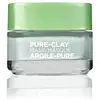What's inside
What's inside
 Key Ingredients
Key Ingredients

 Benefits
Benefits

 Concerns
Concerns

 Ingredients Side-by-side
Ingredients Side-by-side

Water
Skin ConditioningKaolin
AbrasiveMontmorillonite
AbsorbentSilica
AbrasiveLecithin
EmollientPolysorbate 20
EmulsifyingButylene Glycol
HumectantPropylene Glycol
HumectantOryza Sativa Starch
AbsorbentEucalyptus Globulus Leaf Extract
PerfumingGlycerin
HumectantMoroccan Lava Clay
AbrasiveCaprylyl Glycol
EmollientCitric Acid
BufferingXanthan Gum
EmulsifyingMethylparaben
PreservativeSodium Benzoate
MaskingSodium Methylparaben
PreservativePhenoxyethanol
PreservativeChlorphenesin
AntimicrobialCI 61570
Cosmetic ColorantCI 77492
Cosmetic ColorantLinalool
PerfumingGeraniol
PerfumingCoumarin
PerfumingCitronellol
PerfumingParfum
MaskingWater, Kaolin, Montmorillonite, Silica, Lecithin, Polysorbate 20, Butylene Glycol, Propylene Glycol, Oryza Sativa Starch, Eucalyptus Globulus Leaf Extract, Glycerin, Moroccan Lava Clay, Caprylyl Glycol, Citric Acid, Xanthan Gum, Methylparaben, Sodium Benzoate, Sodium Methylparaben, Phenoxyethanol, Chlorphenesin, CI 61570, CI 77492, Linalool, Geraniol, Coumarin, Citronellol, Parfum
Water
Skin ConditioningSynthetic Beeswax
Emulsion StabilisingPalmitic Acid
EmollientAcrylates/Ethylhexyl Acrylate Copolymer
Copernicia Cerifera Wax
Glyceryl Stearate
EmollientPolybutene
Stearic Acid
CleansingC26-28 Alkyl Dimethicone
Skin ConditioningEuphorbia Cerifera Wax
Glycerin
HumectantTribehenin
EmollientAminomethyl Propanediol
BufferingPhenoxyethanol
PreservativeSodium Hyaluronate
HumectantLaureth-21
CleansingEthylhexylglycerin
Skin ConditioningHydroxyethylcellulose
Emulsion StabilisingDisodium Phosphate
BufferingPolysorbate 60
EmulsifyingSodium Phosphate
BufferingCI 77499
Cosmetic ColorantWater, Synthetic Beeswax, Palmitic Acid, Acrylates/Ethylhexyl Acrylate Copolymer, Copernicia Cerifera Wax, Glyceryl Stearate, Polybutene, Stearic Acid, C26-28 Alkyl Dimethicone, Euphorbia Cerifera Wax, Glycerin, Tribehenin, Aminomethyl Propanediol, Phenoxyethanol, Sodium Hyaluronate, Laureth-21, Ethylhexylglycerin, Hydroxyethylcellulose, Disodium Phosphate, Polysorbate 60, Sodium Phosphate, CI 77499
Ingredients Explained
These ingredients are found in both products.
Ingredients higher up in an ingredient list are typically present in a larger amount.
Glycerin is already naturally found in your skin. It helps moisturize and protect your skin.
A study from 2016 found glycerin to be more effective as a humectant than AHAs and hyaluronic acid.
As a humectant, it helps the skin stay hydrated by pulling moisture to your skin. The low molecular weight of glycerin allows it to pull moisture into the deeper layers of your skin.
Hydrated skin improves your skin barrier; Your skin barrier helps protect against irritants and bacteria.
Glycerin has also been found to have antimicrobial and antiviral properties. Due to these properties, glycerin is often used in wound and burn treatments.
In cosmetics, glycerin is usually derived from plants such as soybean or palm. However, it can also be sourced from animals, such as tallow or animal fat.
This ingredient is organic, colorless, odorless, and non-toxic.
Glycerin is the name for this ingredient in American English. British English uses Glycerol/Glycerine.
Learn more about GlycerinPhenoxyethanol is a preservative that has germicide, antimicrobial, and aromatic properties. Studies show that phenoxyethanol can prevent microbial growth. By itself, it has a scent that is similar to that of a rose.
It's often used in formulations along with Caprylyl Glycol to preserve the shelf life of products.
Water. It's the most common cosmetic ingredient of all. You'll usually see it at the top of ingredient lists, meaning that it makes up the largest part of the product.
So why is it so popular? Water most often acts as a solvent - this means that it helps dissolve other ingredients into the formulation.
You'll also recognize water as that liquid we all need to stay alive. If you see this, drink a glass of water. Stay hydrated!
Learn more about Water